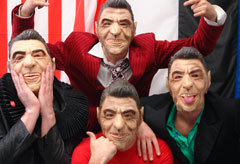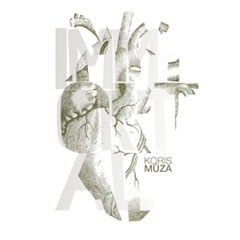
Alternative rock band S.P.B. is among Latvian bands scheduled for the Positivus Festival, which runs July 16-17 in Salacgrīva. (Publicity photo)
If you missed the Jāņi festivals across Latvia last month and will not make it in time for the 10th Latvian Youth Song and Dance Celebration in Rīga (July 6-11), the 16th International Early Music Festival (July 7-10), or the rock music celebration Saldus Saule (July 10), plenty of other cultural events are in the offing for the rest of the summer.
Many of them involve music and cover the range from folk to schlager to rock—with a few twists along the way—and there are events for art lovers, history students and just general sightseers, too. Here is a rundown of just some events, but keep in mind something is going on somewhere in Latvia all summer long:
Through July, the International Organ Music Festival “Rīgas Doms” will bring a series of local and world talent to the Rīga Dom, or cathedral, in the capital city’s Old Town district. Performances began July 2 and run until July 30. This is the 23rd year of the festival, the central component of which is the cathedral’s organ, built from 1883-1884 by Eberhard Friedrich Walcker. “This year,” according to the cathedral’s website, “the concert programmes will be devoted to the centenary of the distinguished Latvian composer and writer Marģers Zariņš, the 325th anniversary of the birth of the German composers Johann Sebastian Bach and Georg Friedrich Händel, the 200th anniversary of the birth of Robert Schumann, and the 175th anniversary of the birth of the French composer Camille Saint-Saëns.” A complete schedule of festival concerts, as well as other musical performances in the cathedral, is available from www.doms.lv.
British alternative rock band Muse and American glam rock band Scissor Sisters will headline the fourth annual Positivus Festival, set July 16-17 in the seaside town of Salacgrīva. More than 40 musical acts will perform during the festival. The festival grounds will include two main stages, a dance tent, a stage for local and international independent acts, as well as stages for cinema, theater and literature presentations. A 12-piece experimental folk band from England called Sons of Noel and Adrian will join the Estonian indie-folk trio Ewert and the Two Dragons as headliners on the I Love You stage for local and independent artists. Also on tap are such Latvian artists as El Mars, Mona De Bo, Martin Confused, Tramplīni and S.P.B. Among other Latvian acts performing during the festival will be rock band Astro’n’out, singer Goran Gora and performance band Trīanas parks. A one-day ticket costs EUR 35 and a two-day ticket is EUR 45. Extra charges apply for those who wish to camp on the festival grounds. Children younger than 10 years will be admitted free if accompanied by an adult. For further details, visit www.positivusfestival.com.
The sea festival Kolkas ragam 970, marking the anniversary when the name of the cape was first mentioned, is scheduled July 17. It is just one of several festivals celebrating Latvia’s relationship with the sea that take place during the summer. Cape Kolka (Kolkas rags) is where the Baltic Sea meets the Gulf of Rīga. During the Kolka festival, attractions are to include beach volleyball, the annual fair, a photography exhibit, a commemoration of those lost at sea, a number of musical performances and other activities. For more details, visit www.kolkasrags.lv.
Another of the big summertime seaside festivals is the Baltic Beach Party in Liepāja. The festival, which runs from July 22-24, this year celebrates its 10th anniversary. When the festival started in 2001, it drew an estimated 7,000 participants, according to organizers. Last year, Baltic Beach Party saw 50,000 visitors, down from the 55,000 who came in 2008 and the 62,000 participants in 2007, but an impressive showing nonetheless. Over the years the beach party has drawn some well-known acts from around Latvia and the rest of Europe, and this month’s event is no different. Among special guest acts are Finland’s Rasmus; Audiosmog and Sash!, both from Germany; and Tuklan from Nigeria. A treat for fans of Latvian rock band Brainstorm (Prāta Vētra) will be a performance by Reigani, which is none other than Brainstorm’s members dressed up in Ronald Reagan masks and singing as a self-described Estonian country punk band. More than 20 Latvian musical acts will perform during the festival, including Labvēlīgais tips, Double Faced Eels, Eolika, Z-Scars and The Briefing. Performances will take place in a dozen venues. Tickets bought in advance range from LVL 5 to LVL 16, varying based on the number of days of attendance. For more information, visit beachparty.lv.
Just as with the sea festivals, a number of cities around Latvia have their hometown festivals. One of the bigger ones will be the Cēsis 2010 art festival, running from July 23 to Aug. 15 in Cēsis. Events include classical music concerts, contemporary art exhibits, and theater and cinema performances. Visitors will be able to view a screening of Japanese film director Akira Kurosawa’s Rashômon on July 27 or catch a performance of “Vectēvs” by the Jaunais Rīgas Teātris on Aug. 7. With funding from the Nordic Culture Point, the festival this year also features a July 24 conference and exhibit focused on how contemporary art and academic music are developing in the Baltic and Scandinavian countries. Details about the festival are found at www.cesufestivals.lv
Even though it has little to do with Latvian music and is focused on talent from farther east, the Jaunais Vilnis (New Wave) competition is a noteworthy annual event in Jūrmala. It is scheduled July 27 to Aug. 1 in the Dzintari Concert Hall. The competition, hosted by popular Latvian composer Raimonds Pauls and Igors Krutojs, is for young talent ages 16-30. Performers this year will be coming from around Eastern Europe, as well as from Brazil and Israel. In all, 17 contestants from 12 countries are in the competition. Latvian acts competing are the girl group Lady’s Sweet (Jolanta Strikaite, Vineta Elksne and Karīna Tropa) and the boy group PeR (Peteris Upelnieks, Edmunds Rasmanis and Ralfs Eilands). Latvian singer Intars Busulis won the contest last year. For further information, visit www.newwavestars.com
The fifth annual underground music festival Zvērā, offering a mix of musical genres, is scheduled July 30-31 in Saldus. Performers from Latvia and the rest of Europe, as well as from Brazil and Canada, are set for the festival. Among the main attractions are The Ocean from Germany, As We Fight from Denmark, and Paura from Brazil, as well as Inokentijs Mārpls from Latvia. Tickets are LVL 13 in advance and LVL 15 at the door. For further information, visit www.zverafest.lv.
The community of Stelpe, northeast of Bauska, hosts the Rock Festival Pīlādzis (Rokfestivāls Pīlādzis). The two-day affair, set Aug. 13-14, features open-air performances by a number of Latvian rock bands old and new. Pērkons, Linga and Pienvedēja piedzīvojumi are scheduled, as are Ēnas, Triānas parks and Goran Gora, to name just a few. For children, the festival includes a performance of the play “Brēmenes muzikanti” by the Kabata and UMKA.LV theater troupes. Tickets start from LVL 3 to LVL 9 for the first 1,000 customers, but go up after that. Children to age 12 will be admitted free if accompanied by a parent. For further information, visit www.piladzis.lv.
Appropriate for the summer heat is the Latvian Salsa Festival, scheduled Aug. 13-15 in Rīga. The Latin dance will be celebrated with three days of master classes, performances and competition at the Dance Centre Nianse. One highlight of the event will be the visit of Salsa star Anita Lombardi of Italy. For further information, see the event’s Facebook page.
The 13th International Sacred Music Festival is set Aug. 19 to Sept. 4 in Liepāja, Rīga and Jūrmala. The festival will showcase the State Choir “Latvija” accompanied by Latvian and international artists, including the Liepāja Symphony Orchestra, the Estonian National Symphony Orchestra, the Latvian National Symphony Orchestra. Also performing during the festival will be the EMO Ensemble from Finland. During the festival, the State Choir “Latvija,” directed by Māris Sirmais, will premiere the works “Historical Lithurgy” by Leons Amoliņš and “Cantata for Choir and Orchestra” by Pēteris Butāns. One of the best aspects of the festival, other than the music, is that some of the concerts are free. Tickets for others range in price from LVL 5 to LVL 20. Details may be found at www.sacredmusicfestival.lv.
Local travel guides and websites should be consulted for information about other events.

Organist and composer Yevgenia Lissitsina performs July 25 during the International Organ Music Festival “Rīgas Doms” in Rīga. (Publicity photo)

Reigani, rock group Prāta Vētra’s alter-ego, performs as part of the Baltic Beach Party, scheduled July 22-24 in Liepāja. (Publicity photo)
Andris Straumanis is a special correspondent for and a co-founder of Latvians Online. From 2000–2012 he was editor of the website.







